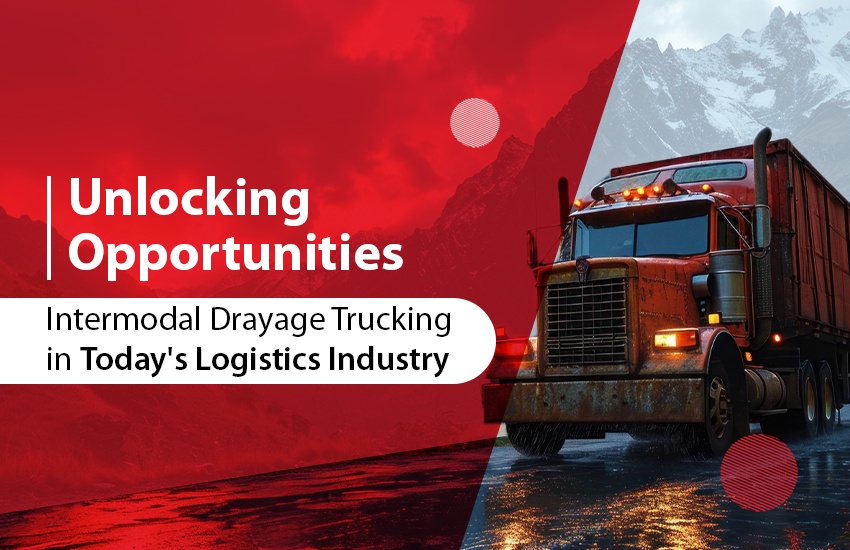Whether it's ships, barges, planes, trains, or even bicycles – the odds are that your latest courier shipment or packages traveled on one of these modes to get to you! Intermodal refers to a system of modes that operate together to deliver shipments from point A to point B efficiently and reliably rather than just one mode that is preferentially used.
In the intricate world of logistics, optimizing operations requires a thorough grasp of each link in the chain. Intermodal drayage is one of those crucial links that help to facilitate the efficient flow of goods or products. Intermodal drayage, an essential component of contemporary logistics, guarantees that commodities move effectively and efficiently in the supply chain by combining various means of transportation.
Understanding Intermodal Drayage Trucking: A Basic Overview
Freight dispatching can be complicated! Every step counts in the world of logistics. Businesses of all shapes and sizes are constantly looking for ways to cut costs, speed up shipping, and maintain the quality of their goods. One lost factor is 'Intermodal and drayage trucking' amid juggling operations.
Intermodal may not be the star of the show, but it is the unsung hero of effective freight shipping. This blog will show you how to use drayage to boost your shipping operations, and for that, you need to know the basics first.
What Is Intermodal and Drayage Trucking?
Intermodal and drayage trucking are closely related to the transportation and logistics industry.
- Intermodal Trucking: Intermodal transportation refers to the movement of goods or shipments using multiple modes of transportation, typically involving a combination of trucking and rail transportation. It consists of standardized shipping containers that can quickly transfer between different modes of transport, such as truck to rail or vice versa.
Intermodal trucking enables efficient movement of goods over long distances and is often used for international shipments and long-haul transportation. The growth of intermodal rail operations usually leads to increased regional and short-haul trucking activities, as trains cannot reach every destination. - Drayage Trucking: On the other hand, drayage trucking refers to transporting goods over a relatively short distance, typically within a local area or between facilities such as ports and warehouses. Drayage is often part of a larger shipment that involves multiple transportation modes, such as transferring containers from ships to truck trailers or vice versa.
The term "drayage" originated from using horse-drawn carts called "drays" to transport goods. In modern-day drayage trucking, trucks are used to carry containers or cargo to and from ports, rail yards, or other intermodal facilities in the local area.
6 Key Advantages of Intermodal Drayage Trucking In 2024
Now that you're familiar with intermodal drayage trucking, you might wonder why it is crucial. Well, there are many reasons why drayage transportation is essential, and we are here to discuss its advantages:
A paradigm shift: understanding Intermodal Transportation
Intermodal drayage trucking represents a paradigm shift in the transportation industry. It involves seamlessly integrating multiple modes of transportation, such as trucks, railways, and waterways, to optimize the movement of goods. This approach allows for greater supply chain operations flexibility, efficiency, and resilience.
Modal Shift: From High Emissions to Efficiency
Intermodal drayage trucking facilitates a modal shift, moving away from traditional truck-only transportation methods associated with high emissions. Companies can significantly reduce their carbon footprint and contribute to a greener logistics industry by utilizing more energy-efficient modes like rail and waterways for long-haul distances.
Energy Efficiency: Maximizing Resources
Intermodal drayage trucking maximizes the utilization of transportation resources. By combining different modes of transport, it enables companies to capitalize on the strengths of each mode. This synergy reduces energy consumption and optimizes resource allocation, increasing energy efficiency.
Eliminating Empty Miles: Optimizing Routes
One of the significant advantages of intermodal drayage trucking is the elimination of empty miles. By leveraging a combination of transportation modes, companies can optimize routes and minimize the number of inefficient, empty truck miles. This reduces costs, alleviates congestion on highways, and reduces carbon emissions.
The Power of Rail and Waterways: Greener Choices
Integrating rail and waterways into intermodal drayage trucking offers greener choices for long-distance transportation. Trains and ships have a significantly lower carbon footprint compared to trucks. Leveraging these modes with trucks ensures a more sustainable supply chain, reducing environmental impacts and enhancing overall sustainability.
Collaborating and Infrastructure Development: Building for The Future
Intermodal drayage trucking requires collaboration among stakeholders and infrastructure development. This approach necessitates establishing intermodal terminals, expanding rail networks, and improving port facilities. By investing in infrastructure and fostering collaboration, businesses can unlock the full potential of intermodal drayage and build a more robust logistics network to meet future demands.
The Future of Intermodal Drayage Trucking
With the rising demand for efficient and sustainable freight forwarding solutions, the future of intermodal drayage trucking looks promising! Technological innovation is vital in addressing a few challenges in this field. So, are you ready to unlock the hidden potential of dray age in your trucking business? Then, we will partner with our 3PL logistics company freight forwarding solutions. Visit our US Ravens website now!!!


No comments yet